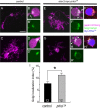Atypical protein kinase C regulates primary dendrite specification of cerebellar Purkinje cells by localizing Golgi apparatus
- PMID: 21159968
- PMCID: PMC6634915
- DOI: 10.1523/JNEUROSCI.3352-10.2010
Atypical protein kinase C regulates primary dendrite specification of cerebellar Purkinje cells by localizing Golgi apparatus
Abstract
Neurons have highly polarized structures that determine what parts of the soma elaborate the axon and dendrites. However, little is known about the mechanisms that establish neuronal polarity in vivo. Cerebellar Purkinje cells extend a single primary dendrite from the soma that ramifies into a highly branched dendritic arbor. We used the zebrafish cerebellum to investigate the mechanisms by which Purkinje cells acquire these characteristics. To examine dendritic morphogenesis in individual Purkinje cells, we marked the cell membrane using a Purkinje cell-specific promoter to drive membrane-targeted fluorescent proteins. We found that zebrafish Purkinje cells initially extend multiple neurites from the soma and subsequently retract all but one, which becomes the primary dendrite. In addition, the Golgi apparatus specifically locates to the root of the primary dendrite, and its localization is already established in immature Purkinje cells that have multiple neurites. Inhibiting secretory trafficking through the Golgi apparatus reduces dendritic growth, suggesting that the Golgi apparatus is involved in the dendritic morphogenesis. We also demonstrated that in a mutant of an atypical protein kinase C (aPKC), Prkci, Purkinje cells retain multiple primary dendrites and show disrupted localization of the Golgi apparatus. Furthermore, a mosaic inhibition of Prkci in Purkinje cells recapitulates the aPKC mutant phenotype. These results suggest that the aPKC cell autonomously controls the Golgi localization and thereby regulates the specification of the primary dendrite of Purkinje cells.
Figures







Similar articles
-
Dendritic morphogenesis of cerebellar Purkinje cells through extension and retraction revealed by long-term tracking of living cells in vitro.Neuroscience. 2006 Aug 25;141(2):663-674. doi: 10.1016/j.neuroscience.2006.04.044. Epub 2006 May 30. Neuroscience. 2006. PMID: 16730917
-
Polarized secretory trafficking directs cargo for asymmetric dendrite growth and morphogenesis.Neuron. 2005 Dec 8;48(5):757-71. doi: 10.1016/j.neuron.2005.11.005. Neuron. 2005. PMID: 16337914
-
[Mechanisms for dendritic morphogenesis of cerebellar purkinje cells: role of receptor-type protein tyrosine phosphatase zeta].Nihon Shinkei Seishin Yakurigaku Zasshi. 2007 Jun;27(3):135-40. Nihon Shinkei Seishin Yakurigaku Zasshi. 2007. PMID: 17633525 Review. Japanese.
-
Remodeling of monoplanar Purkinje cell dendrites during cerebellar circuit formation.PLoS One. 2011;6(5):e20108. doi: 10.1371/journal.pone.0020108. Epub 2011 May 31. PLoS One. 2011. PMID: 21655286 Free PMC article.
-
Dendritic Self-Avoidance and Morphological Development of Cerebellar Purkinje Cells.Cerebellum. 2018 Dec;17(6):701-708. doi: 10.1007/s12311-018-0984-8. Cerebellum. 2018. PMID: 30270408 Review.
Cited by
-
Impairments of cerebellar structure and function in a zebrafish KO of neuropsychiatric risk gene znf536.Transl Psychiatry. 2024 Feb 8;14(1):82. doi: 10.1038/s41398-024-02806-1. Transl Psychiatry. 2024. PMID: 38331943 Free PMC article.
-
Insights into the Role of MicroRNAs in the Onset and Development of Diabetic Neuropathy.Int J Mol Sci. 2019 Sep 18;20(18):4627. doi: 10.3390/ijms20184627. Int J Mol Sci. 2019. PMID: 31540445 Free PMC article. Review.
-
Velocity storage mechanism drives a cerebellar clock for predictive eye velocity control.Sci Rep. 2020 Apr 24;10(1):6944. doi: 10.1038/s41598-020-63641-0. Sci Rep. 2020. PMID: 32332917 Free PMC article.
-
The neuronal Golgi in neural circuit formation and reorganization.Front Neural Circuits. 2024 Dec 5;18:1504422. doi: 10.3389/fncir.2024.1504422. eCollection 2024. Front Neural Circuits. 2024. PMID: 39703196 Free PMC article. Review.
-
Optogenetic manipulation of neuronal and cardiomyocyte functions in zebrafish using microbial rhodopsins and adenylyl cyclases.Elife. 2023 Aug 17;12:e83975. doi: 10.7554/eLife.83975. Elife. 2023. PMID: 37589546 Free PMC article.
References
-
- Altman J, Anderson WJ. Experimental reorganization of the cerebellar cortex. I. Morphological effects of elimination of all microneurons with prolonged x-irradiation started at birth. J Comp Neurol. 1972;146:355–406. - PubMed
-
- Arimura N, Kaibuchi K. Neuronal polarity: from extracellular signals to intracellular mechanisms. Nat Rev Neurosci. 2007;8:194–205. - PubMed
-
- Armengol JA, Sotelo C. Early dendritic development of Purkinje cells in the rat cerebellum. A light and electron microscopic study using axonal tracing in “in vitro” slices. Brain Res Dev Brain Res. 1991;64:95–114. - PubMed
-
- Bae YK, Kani S, Shimizu T, Tanabe K, Nojima H, Kimura Y, Higashijima S, Hibi M. Anatomy of zebrafish cerebellum and screen for mutations affecting its development. Dev Biol. 2009;330:406–426. - PubMed
-
- Baptista CA, Hatten ME, Blazeski R, Mason CA. Cell-cell interactions influence survival and differentiation of purified Purkinje cells in vitro. Neuron. 1994;12:243–260. - PubMed
Publication types
MeSH terms
Substances
LinkOut - more resources
Full Text Sources
Molecular Biology Databases
